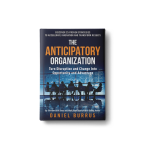Organizations that have adopted an anticipatory mindset and culture enjoy a variety of powerful advantages over those that rely on strategies that simply aren’t as effective as they once might have been.
Business agility is the strategy to react to change as quickly as possible to address problems and changing market conditions.
Does that make business agility an extinct dinosaur? Far from it, so long as you understand its strengths and weaknesses.
Why business agility is no longer enough
Countless organizations have long prized agility as the best way to deal with the speed of change and disruption.
The prevailing mindset was:
the faster and more efficiently you were able to react, the quicker off the mark you would be with regard to beating your competitors to the punch
The increasing number of organizations being disrupted by digital technology clearly indicates that agility is simply no longer as useful. It may have been the key strategy that once protected and defended your company against change, but not anymore.
Given the ever-increasing speed with which technology is driving change of all sorts, agility in many cases can only slow down the speed with which you fall behind.
It’s like being a tightrope walker who sees that the cable is about to break. You can be as agile as the day is long, but you’re still headed for a fall!
Further, being agile doesn’t lend itself to innovation, particularly the sort of game-changing innovation that every organization strives for.
For example, one of Time magazine’s choices for great innovations was an adaptive device that, once connected to a stethoscope, automatically transfers data to a smartphone for ready analysis. The device can identify health issues that a human ear often can’t detect.
Did the developers of that innovation use agility to come up with their breakthrough idea? Being agile would not have helped. Agile innovation is good, but it will position you as a follower and keep you from jumping ahead.
The place for agility
So, given the stage of exponential change we are currently in, does the reactive nature of business agility provide enough, or should we give it a decent burial?
Not at all!
The ability to be agile is a key strategy in both an organization’s and an individual’s toolbox.
After all, there are always going to be unpredictable problems that demand rapid solutions. There’s always unforeseen situations that mandate fast decisions, and other shifts and challenges that require quick analysis and response.
But it’s important to keep business agility in a proper context.
Agility is the ideal strategy for:
- Unpredictable change.
- Reacting quickly after a change occurs.
- Solving problems quickly after they occur.
- Creating a competitive advantage over slower rivals.
In other words, agility is a reactive strategy, and you should be using it as a key strategy, but don’t treat it as the panacea to change and innovation that many organizations assume it still is.
Reaction is all well and good, but it doesn’t allow you to leap ahead in both your thinking and action.
At the very least, it’s just another step in the dance that protects the status quo.
Anticipation—the more powerful option
Let’s be clear: I want you to be agile, and no methodology will allow you to accurately predict everything.
But, business agility needs to be balanced with a new key strategy—becoming anticipatory if you want to become the disruptor and turn change into game-changing opportunity.
It may seem the stuff of science fiction to some, but our Anticipatory Organization Model has proven itself over time and is geared toward showing both organizations and individuals how to anticipate the future and make bold moves with the utmost confidence. It’s the ideal strategy for:
- Turning disruption and change into an opportunity.
- Identifying and acting on the change before it occurs.
- Identifying and pre-solving problems before they occur.
- Driving exponential innovation with reduced risk.
- Jumping ahead of competitors with the confidence that comes from certainty.
One of the keys lies in the proven methodology of identifying both Hard and Soft Trends.
Hard Trends are about future facts. They will happen, they are those future events we can all bank on that is becoming more sophisticated and useful at a predictable, exponential rate.
By contrast, Soft Trends are based on assumptions and represent future possibilities—things that may or may not occur but which are open to influence.
Leveraging those two concepts allows organizations to plan and carry out strategy with a newfound level of confidence that fosters rapid growth and accelerated innovation.
Conclusion
There will always be a place for business agility in the most successful and prosperous organizations. But we need to know that a focus on agility doesn’t preclude the far more proactive ability to be anticipatory whenever possible.
The ideal would be to consider agile and anticipatory as synergistic strategies.
When used together with strategic intent, they can accelerate innovation, growth, and results.
By adopting an anticipatory mindset and culture, change and disruption become your biggest competitive advantage.

Move beyond agility. Find out how anticipation accelerates innovation and shapes the future. Click here to pre-order Anticipatory Organization, the book.
What do you think about business agility and anticipation? Leave a comment in the section below and let me know!
For more business tips, check our finance section and subscribe to our weekly newsletters.






